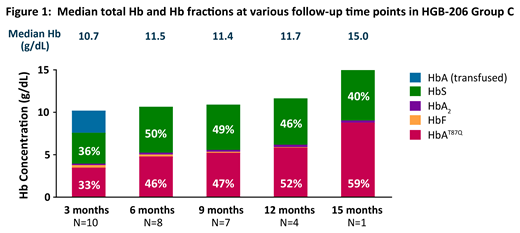
Background
β-globin gene transfer into hematopoietic stem cells (HSCs) could reduce or eliminate sickle cell disease (SCD)-related manifestations. LentiGlobin for SCD gene therapy contains autologous CD34+ cells transduced with the BB305 lentiviral vector (LVV), encoding a human β-globin gene with the anti-sickling T87Q mutation (βA-T87Q). The safety and efficacy of LentiGlobin for SCD is being evaluated in the ongoing Phase 1/2 HGB-206 Study (NCT02140554). The initial 7 patients (Group A) were treated with LentiGlobin made from bone marrow harvested HSCs. The protocol was modified to improve HbAT87Q production by including pre-harvest red blood cell (RBC) transfusions, increasing the total busulfan exposure, and using a refined LentiGlobin manufacturing process (Group B, n=2). An additional modification was made for Group C patients where HSC collection by plerixafor mobilization followed by apheresis was instituted. Data from these Group C patients are discussed here. Results from patients in Groups A and B are reported separately.
Methods
Patients (≥ 18 years) with severe SCD (including those with recurrent vaso-occlusive crisis [VOC] and acute chest syndrome [ACS]) were screened for eligibility. Patients received 240 µg/kg of plerixafor 4-6 hours prior to HSC collection via apheresis. CD34+ cells were transduced with BB305 LVV. Patients underwent myeloablative busulfan conditioning and subsequent LentiGlobin drug product (DP) infusion. Patients were monitored for adverse events (AEs), engraftment, vector copy number (VCN), total hemoglobin (Hb) and HbAT87Q expression, hemolysis markers, and SCD clinical manifestations. Data are presented as median (min-max).
Results:
As of 7 March 2019, 19 Group C patients, aged 26 (18-36) years, had initiated mobilization/apheresis and 13 patients were treated with LentiGlobin for SCD gene therapy. Median DP VCN, % transduced cells, and CD34+ cell dose in the 13 treated patients were: 3.8 (2.8-5.6) copies/diploid genome (c/dg), 80 (71-88) %, and 4.5 (3.0-8.0) x 106 CD34+ cells/kg, respectively. The median follow-up was 9.0 (1.0-15.2) months. Twelve patients achieved neutrophil and platelet engraftments at a median of 19 (15-24) days and 28 (19-136) days, respectively. As of the data cut-off, engraftment was not yet evaluable in 1 patient at 1-month post-infusion.
All patients stopped red blood cell (RBC) transfusions within about 3 months post-LentiGlobin gene therapy. Median total hemoglobin (Hb) and Hb fractions in patients at various time points are shown in Figure 1. Median HbS levels were at or below 50% in all patients with at least 6 months follow-up. The median total Hb at last visit in 8 patients with at least 6 months of follow-up, was 11.5 (10.2-15.0) g/dL, with a corresponding HbAT87Q median contribution of 5.3 (4.5-8.8) g/dL and a median HbS 5.7 (4.8-8.0) g/dL. Of these 8 patients, 6 had a history of VOCs or ACS. The median annualized VOC+ACS rate in these patients was 5.3 (3-14) pre-treatment and decreased to 0 (0-2)
post-treatment. One Grade 2 VOC was observed 3.5 months post-treatment. No ACS or serious VOCs were observed in Group C patients' post- treatment. Lactate dehydrogenase, reticulocyte count, and total bilirubin at last visit post-LentiGlobin infusion were 225.0 (130.0-337.0) U/L, 150.0 (42.1-283.0) 109/L, 22.2 (3.42-39.3) µmol/L, respectively, trending towards normalization.
The most common non-hematologic Grade ≥ 3 AEs were febrile neutropenia (n=10) and stomatitis (n=7) post-DP infusion. Serious AEs were reported in 6 patients post-LentiGlobin treatment, most common being nausea and vomiting. To date, there have been no DP-related AEs or graft failure, vector-mediated replication competent lentivirus detected, or clonal dominance reported. Longer follow-up and additional patient data will be presented.
Summary
The safety profile of LentiGlobin gene therapy for SCD remains consistent with single-agent busulfan conditioning and underlying disease. Patients in HGB-206 Group C experienced high-level, sustained expression of gene-therapy derived hemoglobin, with median HbS levels reduced to ~50% and median total Hb levels of 11.5 g/dL at 6 months. The cessation of clinical complications (no ACS or serious VOCs) and decreased hemolysis suggest a strong therapeutic effect after LentiGlobin gene therapy in patients with SCD.
Kanter:Peerview: Honoraria; NHLBI: Membership on an entity's Board of Directors or advisory committees; Rockpointe: Honoraria; SCDAA: Membership on an entity's Board of Directors or advisory committees; Novartis: Consultancy, Honoraria; Imara: Consultancy; Jeffries: Consultancy; Modus: Consultancy; Guidepoint Global: Consultancy; GLG: Consultancy; Cowen: Consultancy; bluebird bio, Inc: Consultancy; Medscape: Honoraria; Sangamo: Consultancy. Kwiatkowski:Terumo: Research Funding; Novartis: Research Funding; Apopharma: Research Funding; Imara: Consultancy; Celgene: Consultancy; bluebird bio, Inc.: Consultancy, Research Funding; Agios: Consultancy. Schmidt:German Cancer Research Center, Heidelberg, Germany: Employment; GeneWerk GmbH, Heidelberg, Gemrany: Equity Ownership. Miller:bluebird bio, Inc.: Employment, Equity Ownership. Pierciey:bluebird bio, Inc.: Employment, Equity Ownership. Huang:bluebird bio, Inc.: Employment, Equity Ownership. Ribeil:bluebird bio, Inc.: Employment, Equity Ownership. Thompson:Baxalta: Research Funding; Novartis: Consultancy, Research Funding; Celgene: Consultancy, Research Funding; bluebird bio, Inc.: Consultancy, Research Funding. Walters:AllCells, Inc: Consultancy; TruCode: Consultancy; Editas Medicine: Consultancy.
Author notes
Asterisk with author names denotes non-ASH members.

This icon denotes a clinically relevant abstract


